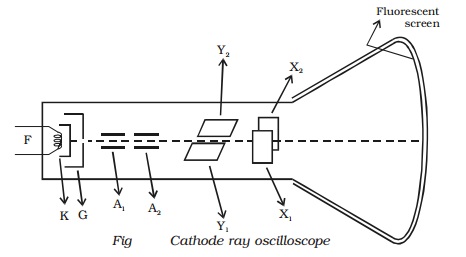Chapter: 11th 12th std standard Class Physics sciense Higher secondary school College Notes
Cathode ray oscilloscope (CRO)

Cathode ray oscilloscope (CRO)
This device is the most useful
electronic instrument. This gives visual representation of electrical
quantities such as voltage and frequency in any electronic circuit. It makes
use of the properties of cathode rays, which are deflected in electric and
magnetic fields and produce scintillation on fluorescent screen (Fig).

CRO consists of three sections
(i) an electron gun (ii) a deflection system (iii) a fluorescent screen. These
are enclosed in a glass tube, which is completely evacuated.
(i) Electron gun
The electron gun consists of a
cathode K, a control grid G and along with them two anodes A1 and A2.
Electrons which are emitted from the indirectly heated cathode K, passes
through the hole in the cylindrical grid G, towards the anode. Due to the
negative potential of G with respect to cathode, these electrons bunch
together, forming a beam of electrons coming out of G. The electron beam is
accelerated by the two cylindrical anodes A1 and A2. Then
the electron beam strikes the fluorescent screen.
(ii) Deflection system
With the help of two pairs of the
plates X1, X2 and Y1, Y2, the
electron beam travelling towards the screen can be deflected. These plates are
placed between the path of the beam beyond the anode A2. Y1,
Y2 plates are called Y-plates and X1, X2
plates are called X-plates. The Y plates are kept horizontal and X plates kept
vertical along the direction of the beams.
The electron beam will be
deflected along the vertical direction, if a DC potential is applied to Y
plates and the electron beam will be deflected along the horizontal direction,
with the potential on X-plates.
(iii) Fluorescent screen
The glass tube is coated with a
fluorescent material. When the beam strikes the screen a light spot is visible.
The electrons striking the screen are returned to the power supply via the
inner surfaces of the glass envelope, usually coated with graphite. This
coating is connected to anode A2 by a lead-in wire.
Uses
(i)
It is used to measure a.c and d.c voltage.
(ii) It is used to study the waveforms
of a.c voltages.
(iii)
It is used to find the frequency of a.c voltage.
(iv)
It is used to study the beating of heart in cardiology.
Related Topics